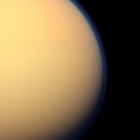Understanding Haze Formation in Planetary Atmospheres: Lessons from the Lab
From exoplanets, with their surprising lack of spectral features, to Titan and its characteristic haze layer, numerous planetary atmospheres may possess photochemically produced particles or haze. With few exceptions, we lack strong observational constraints (in situ or remote sensing) on the size, shape, density, and composition of these particles. Photochemical models, which can generally explain the observed abundances of smaller, gas phase species, are not well suited for investigations of much larger, solid phase species. Laboratory investigations of haze formation in planetary atmospheres therefore play a key role in improving our understanding of the formation and composition of haze particles. I will discuss a series of experiments aimed at improving our understanding of haze in the atmospheres of Titan, the early Earth, exoplanets, and any other atmospheres composed of a combination of N2, CH4, CO, CO2, and/or O2. In particular, I will discuss investigations of the density of Titan aerosol analogues (“tholins”), the effect of energy source on incorporation of nitrogen into tholin, the effect of CO on haze formation, and the possible presence of haze during the rise of oxygen on the early Earth.

